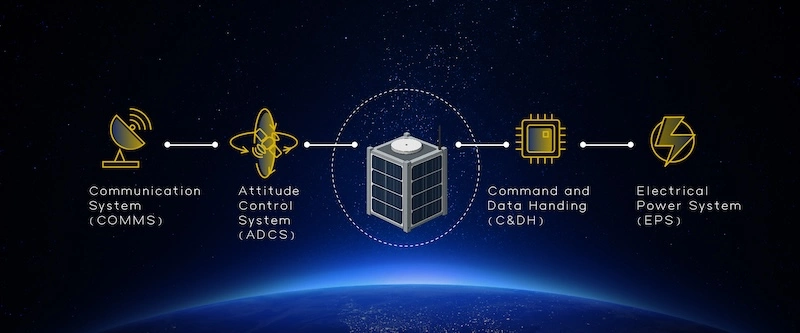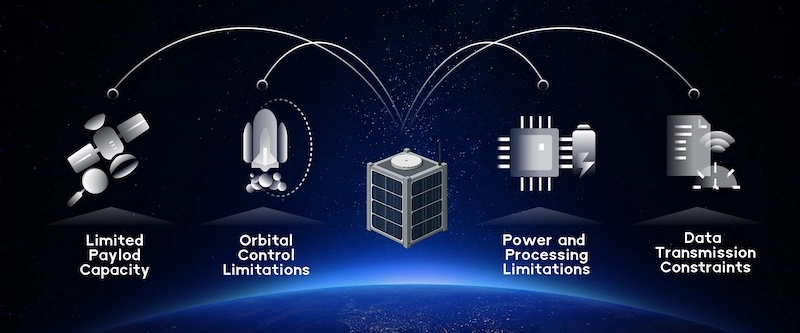CubeSat Satellites: Driving Innovation in Small-Scale Space Missions

Authored by Afan Huang
CubeSat satellites have revolutionized the space industry by making satellite technology accessible to universities, startups, and research institutions worldwide. This comprehensive guide explores how these miniaturized spacecraft are transforming space missions through standardized design, cost-effective components, and innovative deployment strategies.

CubeSats enables space access for diverse institutions.
Key Features of CubeSat Satellites
CubeSat satellites represent a paradigm shift in spacecraft design, offering unprecedented accessibility to space through their standardized architecture and modular approach. These miniaturized satellites have democratized space exploration by reducing barriers to entry.
〈Related Reading:Cube Satellites: Unlocking Space for Everyone〉
Standardized Size and Design of CubeSat Satellites
The fundamental building block of CubeSat satellites is the 1U unit, measuring exactly 10×10×10 centimeters with a mass of approximately 1 to 2 kilograms. This standardization has simplified the design and manufacturing process across the industry, creating economies of scale that benefit all stakeholders. The modular nature allows mission designers to combine multiple units (2U, 3U, 6U, or even 27U configurations) based on specific requirements, providing exceptional flexibility for various applications. This standardized approach has established common interfaces, deployment mechanisms, and testing procedures, significantly reducing development time and costs while ensuring compatibility with standard launch systems.
Commercial-Off-The-Shelf (COTS) Components in CubeSat Satellites
CubeSat satellites extensively utilize Commercial-Off-The-Shelf (COTS) components, leveraging the rapid advancement and cost reduction of consumer electronics. Critical internal components such as processors, sensors, cameras, and communication modules are often sourced from smartphone and computer industries. This approach is particularly viable because CubeSats typically operate in Low Earth Orbit (LEO), where radiation levels and space environment conditions are less severe compared to higher orbits, making COTS components practical for mission use. This approach not only makes CubeSat satellites economically viable but also accelerates the integration of cutting-edge technology into space applications. The use of COTS components enables shorter development cycles, as teams can focus on mission-specific software and system integration rather than developing custom hardware from scratch. However, this requires careful selection and testing to ensure components can withstand the space environment challenges present even in LEO.
〈Related Reading:What Is a Control Moment Gyroscope (CMG)? A Powerful Solution for Satellite Attitude Control〉
Launch and Deployment Methods for CubeSat Satellites

A rocket launching with CubeSats deploying from both a CSD (larger satellites) and a P-POD (smaller satellites).
CubeSat satellites typically operate as secondary payloads or "rideshare passengers" on larger rocket missions, dramatically reducing launch costs compared to dedicated missions. This piggyback approach has made space access affordable for educational institutions and small companies, with launch costs varying significantly based on orbit, launch provider, and mission requirements.
POD Deployers for Small CubeSats
POD (Picosatellite Orbital Deployer) systems are standardized deployment mechanisms designed for smaller CubeSat configurations. The P-POD, developed by California Polytechnic State University (Cal Poly), was the original design and can accommodate CubeSats from 1U to 3U. Following this pioneering design, various manufacturers have developed their own POD variants including EXOPOD (Exolaunch), ISIPOD (ISIS - Innovative Solutions In Space), and XPOD (UTIAS Space Flight Laboratory). These deployers use spring-loaded mechanisms to safely eject CubeSats from their protective containers once the deployment signal is received from the launch vehicle.
Canisterized Satellite Dispensers for Larger CubeSats
For larger CubeSat configurations (6U, 12U, 27U), the Canisterized Satellite Dispenser (CSD) provides a more robust deployment solution. Manufactured by Planetary Systems Corporation (now part of Rocket Lab), the CSD fully encapsulates the payload during launch, providing enhanced protection for both the CubeSat and the primary payload. Unlike POD systems that use rails, the CSD employs a tab-based gripping mechanism and utilizes a DC motor-driven door system without pyrotechnics. This design allows for easier integration, rapid cycling for ground testing, and accommodates the larger volumes and masses of multi-unit CubeSat configurations. The standardized deployment containers protect both the CubeSat satellites and primary payloads during launch while ensuring precise orbital insertion timing.
How Do Traditional Satellites Differ from CubeSat Satellites?
The contrast between traditional satellites and CubeSat satellites spans multiple dimensions, from physical characteristics to operational capabilities and development approaches.
Size and Mass Comparison
Traditional satellites typically range from hundreds to thousands of kilograms, occupying volumes measured in cubic meters, while CubeSat satellites weigh between 1 to 20 kilograms and fit within standardized cubic units. This dramatic size difference affects every aspect of satellite design, from structural requirements to thermal management. The compact form factor of CubeSat satellites necessitates innovative miniaturization techniques and component integration strategies that push the boundaries of engineering design.
Cost and Development Timeline
Traditional satellite missions often require budgets ranging from tens of millions to billions of dollars with development timelines spanning 5 to15 years. In contrast, CubeSat satellites can be developed for $50,000 to $500,000 within 1 to 3 years. This cost-effectiveness stems from simplified design requirements, COTS component usage, and streamlined testing procedures. The reduced financial risk enables more experimental missions and faster iteration cycles for technology demonstration.
Materials and Manufacturing Approaches
Traditional satellites employ specialized aerospace-grade materials and custom manufacturing processes to ensure long-term reliability in harsh space environments. CubeSat satellites balance performance with cost by using selected commercial components housed in aluminum structures, often accepting shorter operational lifespans in exchange for affordability and rapid deployment capabilities.
Application Scope and Mission Complexity
While traditional satellites handle complex, long-duration missions requiring high reliability and extensive capabilities, CubeSat satellites excel in focused applications such as technology demonstration, Earth observation, scientific research, and educational projects. The mission scope reflects the trade-off between capability and accessibility.
Comparison of Traditional and CubeSat Satellites
| Aspect | Traditional Satellites | CubeSat Satellites |
|---|---|---|
| Size | Hundreds to thousands of kg | 1 to 10+ kg |
| Cost | $200M+ to billions | $50K to $500K |
| Development Time | 5 to 15+ years | 1 to 3 years |
| Mission Duration | Extended operational life | 1 to 5 years |
| Launch Method | Dedicated missions | Rideshare / Secondary |
Key Technologies in CubeSat Satellites
The successful operation of CubeSat satellites depends on several critical technological systems that must be miniaturized and optimized for the space environment.
〈Related Reading:How to pick up a suitable CubeSat ADCS〉

Key Technologies in CubeSat
Electrical Power Systems (EPS)
The Electrical Power System manages energy generation, storage, and distribution throughout the CubeSat satellite. Solar panels, typically mounted on external faces, generate power while lithium-ion batteries provide energy during eclipse periods. Power management units regulate voltage levels and implement protective measures against overcurrent and overvoltage conditions. Efficient power budgeting is critical given the limited surface area available for solar panels and the need to support all subsystems within tight energy constraints.
Communication Systems (COMMS)
Communication systems enable CubeSat satellites to transmit scientific data and receive commands from ground stations. Most CubeSat satellites operate in amateur radio frequencies (UHF/VHF bands) or utilize higher-frequency bands for increased data rates. The communication subsystem includes transceivers, antennas, and signal processing equipment designed to maintain reliable links despite the satellite's small size and limited power. Advanced missions may incorporate software-defined radios for flexible communication protocols.
Command and Data Handling (C&DH)
The command and data handling subsystem serves as the central nervous system of CubeSat satellites, coordinating all onboard operations. Modern systems utilize powerful microprocessors capable of running complex flight software while maintaining low power consumption. This subsystem manages task scheduling, data storage, telemetry processing, and autonomous fault detection. The limited computational resources require efficient software architectures and careful resource allocation.
Attitude Control Systems
Attitude control determines the CubeSat satellite's orientation in space, critical for pointing antennas, solar panels, and scientific instruments. Passive systems use permanent magnets or gravity gradient stabilization, while active systems employ magnetorquers, reaction wheels, or miniaturized thrusters. The Attitude Determination and Control System (ADCS) combines sensors like magnetometers, sun sensors, and gyroscopes with control actuators to maintain desired pointing accuracy within mission requirements.
〈Related Reading:An introduction to fine sun sensors〉
Challenges Facing CubeSat Satellites
Despite their advantages, CubeSat satellites encounter several inherent limitations that mission designers must address through innovative solutions.

Challenges for CubeSat: Limited Payload Capacity, Orbital Control Limitations, Data Transmission Constraints, and Power and Processing Limitations
Limited Payload Capacity
The compact size of CubeSat satellites severely restricts payload volume and mass, limiting the types and quantities of scientific instruments that can be accommodated. This constraint affects mission capabilities and data collection potential compared to larger satellites. However, unit stacking allows larger configurations (6U, 12U) that provide additional space for more sophisticated payloads while maintaining cost advantages over traditional satellites.
Orbital Control Limitations
Most CubeSat satellites lack propulsion systems, making them unable to change orbits or extend mission lifetimes through orbital maintenance. This limitation restricts mission planning and eventual disposal options. Advanced CubeSat satellites are beginning to incorporate miniaturized propulsion systems, including electric thrusters and cold gas systems, to provide basic orbital maneuvering capabilities.
Data Transmission Constraints
The small size and power limitations of CubeSat satellites result in reduced data transmission rates compared to larger satellites. Limited onboard storage and infrequent ground station contact windows further constrain data return capabilities. Solutions include improved compression algorithms, higher-gain antennas, and constellation approaches where multiple CubeSat satellites work together to increase overall data throughput.
Power and Processing Limitations
The restricted surface area for solar panels and limited battery capacity constrain available power for CubeSat satellites operations. Similarly, processing capabilities are limited by power budgets and thermal constraints. These challenges drive innovations in low-power electronics, efficient algorithms, and power management strategies. Multi-unit configurations can provide additional power generation and processing capabilities while maintaining economic advantages.
Conclusion
CubeSat satellites have fundamentally transformed the space industry by democratizing access to space technology and enabling rapid innovation in satellite design and deployment. Their standardized architecture, cost-effective approach, and modular flexibility have opened new possibilities for educational institutions, startups, and research organizations to conduct meaningful space missions. While challenges remain in payload capacity, orbital control, and data transmission, ongoing technological advances continue to expand the capabilities of these remarkable small satellites.
The future of CubeSat satellites promises even greater capabilities through improved miniaturization, advanced propulsion systems, and constellation-based missions. As the technology matures, CubeSat satellites will play an increasingly important role in Earth observation, scientific research, technology demonstration, and commercial space applications.
For organizations considering CubeSat satellite missions, professional expertise in component selection, system integration, and mission planning proves invaluable in ensuring project success. If your organization is planning a CubeSat satellite mission, Tensor Tech can support with CubeSat components, ADCS solutions, and system integration services.Contact Us.
〈Related Reading:Exploring ADCS Principles: A Technical Deep Dive into Attitude Determination and Control Systems〉

